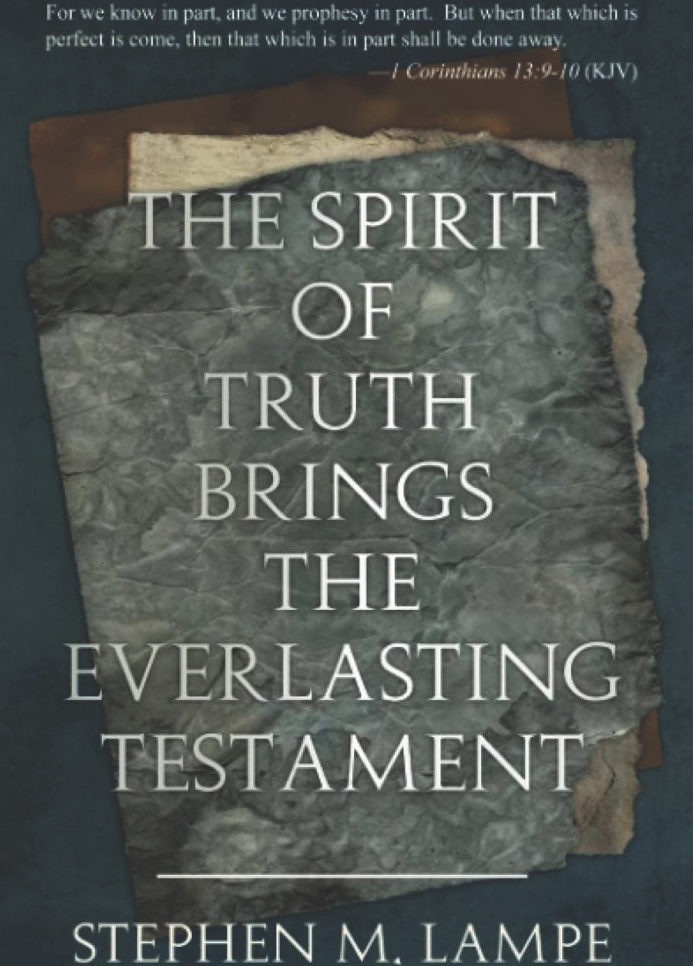The Spirit of Truth Brings the Everlasting Testament, by Stephen Lampe, Millennium Press, 2025, 317 pages
Kolawole Lawani
“I find the biblical ignorance that marks the lives of churchgoers beyond my capacity to exaggerate.” (John Shelby, Episcopal Bishop of Newark, in Rescuing the Bible from Fundamentalism.)
This provocative quote marks one of the opening salvos in Stephen Lampe’s latest contribution to spiritual education: The Spirit of Truth Brings the Everlasting Testament.
Thankfully, he does not write to shame his readers. His goal is to demonstrate that we stand in the End-Time prophesied by Jesus Christ, and that this can be substantiated through the Bible.
Lampe would already be familiar to a number of readers as the author of such illuminating works as The Christian and Reincarnation, Building Future Societies: The Spiritual Principles, Thinking About God: Reflections on Conceptions and Misconceptions, and The Primordial Laws of Creation: Keys to Joyous Achievement of Life’s Purposes.
His new book shakes many a table!
The Bible of the Protestant Churches is different from that of the Catholic Church, which is again different from that of the Greek, Russian, and Ethiopian Orthodox Churches.
The obvious question arises: “Which Bible is ‘the’ Bible”.
Lampe is not seeking to take sides on the issue. Neither is he “knocking” the Bible. Rather, he is arguing for a different approach to understanding and interpreting the Bible.
To illustrate further he cites several issues that many Christians may yet be unaware of. For example:
There are many different translations of John 1:5 (KJV: “And the light shineth in darkness; and the darkness comprehended it not”). Some versions (e.g. ASV – American Standard Version) speak of “apprehended it not”, others (e.g. NIV – New International Version) say “has not overcome it”, others (e.g. NJB – New Jerusalem Bible) render it as “could not overpower it”, still others say “can never extinguish it”, etc. These do not have the same meaning.
KJV Matt 17:21, Matt 23:14, and many other verses are omitted in the Revised Standard Version (RSV), the New Revised Standard Version (NRSV), the NJB, the NIV, and others. Many of these omissions result in significant changes to our interpretation.
This awareness should spur the Christian to deeper study. In effect, Lampe is arguing that we cannot fully understand the Bible without going beyond the Bible. This requires us to be open to new revelations.
Whether we know it or not, many of our views on fundamental issues like gender equality, slavery, racism, etc. have already required us to “look beyond the Bible”.
For example: Ephesians 6:5-9 and 1 Timothy 6:1-2, (NKJV, NRSV, and certain other versions) are not critical of slavery – they are more concerned that slaves should be obedient to their masters. But thinking Christians have already looked beyond the Bible to arrive at a deeper understanding of such matters.
This should not be controversial:
For we know in part, and we prophesy in part.
But when that which is perfect is come,
Then that which is in part shall be done away. (1 Corinthians 13:9-10, KJV)
Paul wrote these words long after the well-known event at Pentecost, and so the coming of the Holy Spirit at Pentecost cannot be what Christ was referring to when He said:
I still have many things to say to you, but you cannot bear them now.
When the Spirit of Truth comes, he will guide you into all the truth:
For he will not speak on his own; but will speak whatever he hears:
And he will declare to you the things that are to come. (John 16:12-13, NRSV)
For Lampe, this approach is crucial to fully understanding what is arguably Christ’s most important prophecy – that regarding the coming of the Son of Man. Is Christ the Son of Man?
If I have told you earthly things, and ye believe not,
How shall ye believe, if I tell you of heavenly things?
And no man hath ascended up to heaven, but he that came down from heaven,
Even the Son of man which is in heaven. (KJV, John 3:12-13)
Christ was on Earth when He made this reference to another Personality in Heaven. For Lampe, this is the same Personality that Christ referred to as the Spirit of Truth.
He carries the investigation much further, delving into both Old and New Testament, e.g.:
John to the seven churches which are in Asia:
Grace be unto you, and peace, from Him which is, and which was, and which is to come;
And from the seven Spirits which are before his throne; And from Jesus Christ, who is the faithful witness, … (KJV, Revelation 1:4-5)
This indicates that Jesus Christ is not the same as He “which is to come”.
Even so, thinking Christians may be justified in saying: “Regardless of who the Son of Man is, people have been expecting him for 2,000 years. What is different now?”
At this point, Lampe provides a new way of looking at the Bible by going beyond the Bible into physics and astronomy. In the same way as the Earth’s orbit defines a “year”, there is such a thing as a “Great Year”, which has to do with the relationship between the plane of the Earth’s equator and the position of the Sun, and which is completed every 25,920 years. Each “month” of this Great Year, which we call an Age, is thus around 2,000 years. This is not merely an arbitrary number, as these Ages have meaning to astronomers who study star configurations.
We lived in the time of the Old Testament (the Age of The Father) for about 2,000 years from the time of Abraham to the time of Christ and we have lived in the time of the New Testament (the Age of The Son) for about 2,000 years. The same logic indicates that we are now due for the Everlasting Testament – the Age of the Holy Spirit!
And I saw another angel fly in the midst of heaven,
Having the everlasting gospel to preach unto them that dwell on the earth,
And to every nation, and kindred, and tongue, and people, Saying with a loud voice,
Fear God, and give glory to him;
For the hour of his judgment is come:
And worship him that made heaven, and earth, and the sea, and the fountains of waters. (KJV, Revelation 14:6-7)
Clearly, an Everlasting Testament will leave no gaps. It will glorify Christ while explaining His teachings to us once again. It will shed light on all the issues facing humanity – religious, scientific, economic, social, etc.
A key resource Lampe cites for further investigation along these lines is the three-volume work In The Light of Truth: The Grail Message, by Abd-ru-shin.
Lampe’s book is a study in thorough and accessible scholarship. This reviewer would go so far as to say that, irrespective of whether the reader agrees or disagrees with the author, there is no thinking Christian that will not learn many new and valuable things from this work.
Therefore, it is highly recommended.
* Lawani writes from Lagos and blogs at https://www.worddiscovered.com.

















Leave a comment